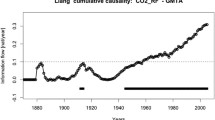Abstract
In this paper, we analyze the Granger causality from natural or anthropogenic forcings to global temperature anomalies. The lag-augmented Wald test is performed, and its robustness is also evaluated considering bootstrap method. The results show there is no-evidence of Granger causality from natural forcings to global temperature. On the contrary, a detectable Granger causality is found from anthropogenic forcings to global temperature confirming that greenhouse gases have an important role on recent global warming.



Similar content being viewed by others
Notes
The results are available from the author upon request.
References
Attanasio A, Pasini A, Triacca U (2012) A contribution to attribution of recent global warming by out-of-sample Granger-causality analysis. Atmos Sci Lett 13:67–72
Attanasio A, Triacca U (2011) Detecting human influence on climate using neural networks based Granger causality. Theor Appl Climatol 103:103–107
Clark T (2004) Can out-of-sample forecast comparisons help prevent overfitting? J Forecasting 23:115–139
Chao J, Corradi V, Swanson N (2001) Out-of-sample test for Granger causality. Macroecon Dyn 5:598–620
Dickey D, Fuller WA (1981) Likelihood ratio statistic for autoregressive time series with a unit root. Econometrica 49:427–431
Elsner JB (2007) Granger causality and Atlantic hurricanes. Tellus 59:476–485
Engle RF, Granger CWJ (1987) Co-integration and error correction: representation, estimation, and testing. Econometrica 55:251–276
Gelper S, Croux C (2007) Multivariate out-of-sample tests for Granger causality. Comput Stat Data An 51:3319–3329
Giles DEA (1997) Causality between the measured and underground economies in New Zealand. Appl Econ Lett 4:63–67
Granger CWJ (1969) Investigating causal relations by econometric methods and cross-spectral methods. Econometrica 37:424–438
Granger CWJ (1981) Some properties of time series data and their use in econometric model specification. J Econometrics 16:121–130
Granger CWJ (1988) Causality, cointegration, and control. J Econ Dyn 12:551–559
Hacker RS, Hatemi-J A (2006) Tests for causality between integrated variables using asymptotic and bootstrap distributions: theory and application. Appl Econ 38:1489–1500
Haldrup N, Lildholdt P (2002) On the robustness of unit root tests in the presence of double unit roots. J Time Ser Anal 23:155–171
Hamilton JD (1994) Time series analysis. Princeton University Press, Princeton, NJ.
Hatemi-J A, Shukur G (2002) Multivariate-based causality tests of twin deficits in the US. J Appl Stat 29:817–824
Kaufmann RK, Stern DI (1997) Evidence for human influence on climate from hemispheric temperature relations. Nature 388:39–44
Kodra E, Chatterjee S, Ganguly AR (2011) Exploring Granger causality between global average observed time series of carbon dioxide and temperature. Theor Appl Climatol 104:325–335
Inoue A, Kilian L (2004) In-sample or out-of-sample tests of predictability: which one should we use? Economet Rev 23:371–402
IPCC (2001) Climate change 2001: the scientific basis. Cambridge University Press, Cambridge, UK and New York, NY, USA
Liu H, Rodriguez G (2005) Human activities and global warming: a cointegration analysis. Environ Modell Softw 20:761–773
Lukasz L (2010) Application of bootstrap methods in investigation of size of the Granger causality test for integrated VAR systems. Manag Glob Transit 8:167–186
Lutkepohl H, Kratzig M (2004) Applied time series econometrics. Cambridge University Press, Cambridge, UK
Mantalos P (2000) A graphical investigation of the size and power of the Granger-causality tests in integrated-cointegrated VAR systems. Stud Nonlinear Dyn E 4:17–33
Mavrotas G, Kelly R (2001) Old wine in new bottles: testing causality between savings and growth. Manch Sch 69:97–105
Mokhov II, Smirnov DA (2008) Diagnostics of a cause-effect relation between solar activity and the Earth’s global surface temperature. Izv Atmos Ocean Phys 44:263–272
Pasini A, Lorè M, Ameli F (2006) Neural network modelling for the analysis of forcings/temperatures relationships at different scales in the climate system. Ecol Model 191:58–67
Phillips PCB, Ouliaris S (1990) Asymptotic properties of residual based tests for cointegration. Econometrica 58:165–193
Reichel R, Thejll P, Lassen K (2001) The cause-and-effect relationship of solar cycle length and the Northern Hemisphere air surface temperature. J Geophys Res 106:635–641
Shukur G, Mantalos P (2000) A simple investigation of the Granger-causality test in integrated-cointegrated VAR systems. J Appl Stat 27:1021–1031
Sims CA, Stock JH, Watson MW (1990) Inference in linear time series models with some unit roots. Econometrica 58:113–144
Stern DI, Kaufmann RK (1999) Econometric analysis of global climate change. Environ Modell Softw 14:597–605
Stock JH, Watson MW (1989) Interpreting the evidence on money-income causality. J Econom 40:161–81
Sun L, Wang M (1996) Global warming and global dioxide emission: an empirical study. J Environ Manage 46:327–343
Toda HY, Yamamoto T (1995) Statistical inference in vector autoregression with possibly integrated processes. J Econometrics 66:225–250
Triacca U (1998) Non-causality: the role of the omitted variables. Econ Lett 60:317–320
Triacca U (2001) On the use of Granger causality to investigate the human influence on climate. Theor Appl Climatol 69:137–138
Triacca U (2002) Selection of the relevant information set for predictive relationships analysis between time series. J Forecasting 21:595–599
Triacca U (2005) Is Granger causality analysis appropriate to investigate the relationship between atmospheric concentration of carbon dioxide and global surface air temperature? Theor Appl Climatol 81:133–135
Acknowledgements
I am grateful to anonymous referees for their valuable comments. I would like to thank Prof. U. Triacca and Dr. A. Pasini for the useful discussions and suggestions on a preliminary version of this paper, andM.E. Basilici for the advice on the language. All statistical computations were done using gret. Any remaining lack of clarity are my own responsibility.
Author information
Authors and Affiliations
Corresponding author
Rights and permissions
About this article
Cite this article
Attanasio, A. Testing for linear Granger causality from natural/anthropogenic forcings to global temperature anomalies. Theor Appl Climatol 110, 281–289 (2012). https://doi.org/10.1007/s00704-012-0634-x
Received:
Accepted:
Published:
Issue Date:
DOI: https://doi.org/10.1007/s00704-012-0634-x




